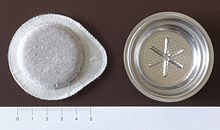Coffee pad
A coffee pod is a one- serving dose (about seven grams for a cup) of coffee powder in a portion packaging (similar to a tea bag ) that is sufficient for one cup of coffee . The coffee pods cannot be brewed with a normal coffee machine , but only in a coffee pod machine .
The envelope for the coffee, the so-called non-woven filter, is usually of two pulp layers , the hot-pressed without using adhesive are bonded together. They are therefore compostable.
Coffee pods were developed in 2001 by Douwe Egberts together with Philips for the Senseo system. However, they are based on the earlier Illy espresso pods by Italian inventor Antonino Di Leva . Almost all well-known coffee roasters such as Tchibo, Melitta , Jacobs and Dallmayr as well as some own brands of supermarkets and discounters also offer coffee pods that are compatible with Senseo. The Austrian company Julius Meinl tried to bring coffee pods to the market for the catering trade, but production of the pods was discontinued due to insufficient demand.
After the success of coffee pods, thinner tea pods , thicker cappuccino pods (with milk powder) and chocolate pods (with milk / cocoa powder for the preparation of hot chocolate ) are now also available.
In addition, the ESE standard (English ESE: Easy Serving Espresso ) for machines with 10 to 15 bar pressure has developed as an open standard (for comparison: Senseo <3 bar). With a diameter of 44 mm, these pads are also significantly smaller than the Senseo-compatible pads with a diameter of 70 mm. The two coffee pad systems are not compatible with each other.
In the trade, coffee pods can be sold at a much higher price per gram compared to coffee powder.
See also
Individual evidence
- ↑ Sandro Mattioli: The poor inventor of the coffee pods. Financial Times Deutschland, July 18, 2010 ( Memento from December 3, 2012 in the web archive archive.today )


